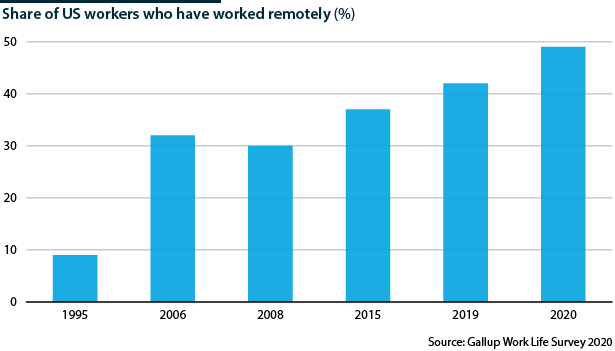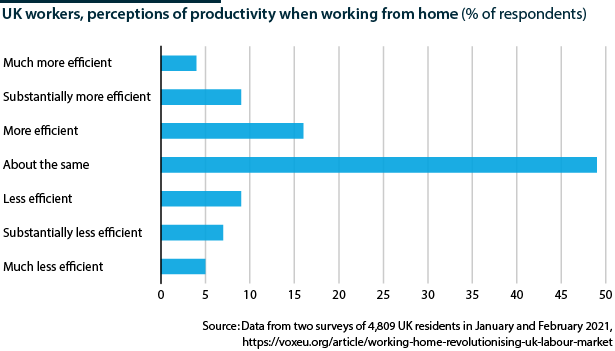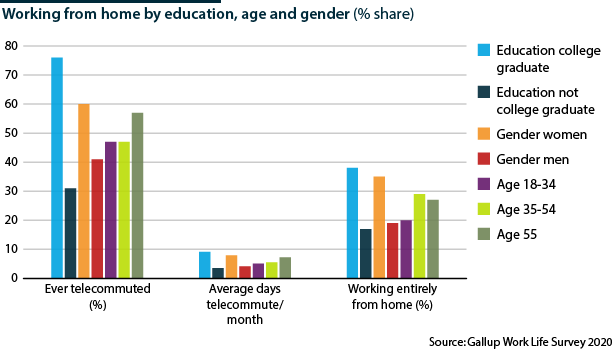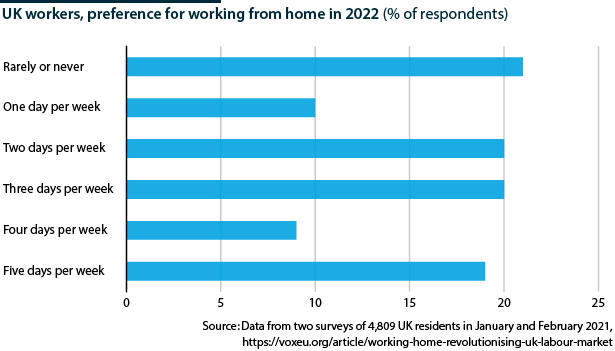Part-remote-part-office work models will evolve
‘Back to the office’ calls by large tech and finance firms query assumptions that the shift to home working is permanent
Large technology and financial services firms are expediting the return to the office of staff forced by the pandemic to work from home. Employers' desire to get their employees back together in person will be at odds with most employees' wish for more remote working, post-pandemic. How the return to work is managed, especially technology for health and safety monitoring and enforcement, will set new employment norms.
What next
There will be considerable variation in the mix of home and office working within and between sectors. Some employers will allow regular but part-time remote working; others will grant it occasionally but flexibly. Employees with hard-to-find skills will be best placed to dictate working arrangements. Technology-enabled health and safety protocols will expand tracking of employees, intensifying conflicts between employers' rights to monitor workforces and employees' concerns over privacy.
Subsidiary Impacts
- Hybrid working models will ease real-estate industry fears of a deep, permanent reduction in demand for commercial office space.
- Economic development agencies in small cities will expand micro incentives to attract individuals able to work remotely.
- Returning to the office and expected labour churn will require companies to run re-induction courses for staff.
- Eateries catering to office workers will pivot to digital direct-to-consumer models with more delivery and takeout, advantaging brands.
Analysis
The speed with which large and medium-sized companies adapted to their white-collar workforces necessarily working remotely when the pandemic struck a year ago diminished resistance from senior executives to the practice (see INTERNATIONAL: COVID-19 to alter working patterns - April 6, 2020).
However, the assumption that remote working would become a norm, letting companies offer staff a perceived benefit while reducing costs through occupying less office space and hiring staff at lower salaries from anywhere, is now being questioned (see INTERNATIONAL: Investor vaccine response flags trends - December 24, 2020).
Tech companies such as Google and Microsoft were among the first to tell staff they would be working remotely. They are now re-opening offices and expediting timelines for returns. Large financial firms such as JPMorgan Chase expect staff, particularly those who directly contact customers and clients, to return to their offices and plan to start intern programmes in mid-year.
Two sides
Employees and employers found advantages and disadvantages to remote work. For employees, it provided some flexibility in working hours and location, important for work-life balance, especially for those that had to care for children or the elderly. It has freed workers from the financial and temporal costs of commuting.
Surveys suggest that many employees favour part-remote-part-office models
Nevertheless, some miss the social aspects of office life. They also fear that not being present diminishes promotion prospects. Many also found working from home raised stress levels, especially parents and those living in small apartments or multigenerational homes.
Multiple surveys have shown these concerns to be substantive, but also that employees' attitudes to working remotely can vary widely between individuals doing the same job and can swing back and forth within the same individual.
Employers' concerns about the productivity of remote workers, in part a proxy for fears of loss of management control, have dissipated. Multiple studies of white-collar productivity suggest that location matters less for productivity than a company's management and communications practices.
Employers are now uneasy about eroding corporate cultures, weakening employee engagement and a loss of the in-person collaboration that spurs innovation. Senior executives do not believe that video conferencing and online collaborative tools like Slack and Microsoft Teams can replace the proverbial 'water-cooler' conversations or that Zoom cocktail hours substitute for informal brainstorming and networking over lunch or in a bar or coffee shop after work.
It will take the elevation of management of a younger generation of 'colabarapp' natives to dispel those concerns and make full use of collaborative software's capabilities.
Hybrid models
Bridging the post-pandemic expectations of employers and employees will be challenging
A Harvard Business School Online survey fielded in March of 1,500 white-collar remote US workers found that three out of five wanted to continue working 2-3 days a week from home, and fewer than one in five wanted to go back to the office full-time.
New guidelines at Google, regarded as an industry bellwether, posit regular remote working as the exception, not the rule. The company is expecting all staff back in the office by September 1. After that, working remotely for more than 14 days per year will require annual approval to be granted only in exceptional circumstances and for a short period.
However, there is no broad corporate consensus on whether remote working will be an occasional, flexible benefit for short-term convenience or a routine elment of new working arrangements, as many workers want. Nor is there consensus among companies open to new models of working on the division of time between home and office. A minority of companies will be fully virtual.
Labour churn
Several US surveys find that more than one in five workers may change jobs for a post-pandemic fresh start. At the same time, companies report that skills mismatches have caused hiring difficulties, despite high levels of unemployment. Highly qualified employees will have leverage over employers in determining their working arrangements.
Health and safety
Bringing office workers back safely and productively will require adaptations to previous practices. Companies can require vaccination verification for office access but not as a condition of employment. The Biden administration has said it will not issue federal vaccine passports.
Other adaptions will be physical but change behaviour, such as:
- redesigning offices to allow adequate distance between individuals and contactless operation of equipment;
- adding meeting spaces and cutting personal offices, cubicles and desks, as the office becomes more of a venue for meetings and hot-desking, while individual work is done elsewhere;
- ensuring IT systems accommodate robust and seamless in-office and remote networks and securing them from cyberattack; and
- installation of technology-enabled devices to facilitate health and safety protocols, from infrared thermometers that can check employees' temperatures from a distance to thermal cameras to measure distancing between employees and send app-based alerts to those who are too close.
Employee monitoring
The data that companies gather on the productivity, behaviour and health of their employees will grow. Digital tracking of employees' work and behaviour accelerated significantly during the pandemic. A study by the Gartner Group found that one in four of the large companies it surveyed installed employee monitoring software in the first three months of the pandemic. An estimated 80% of large companies now employ 'non-traditional' monitoring, such as location tracking and sentiment analysis of internal emails. Gartner reported the ratio in 2015 as 30%.
Privacy
Companies defend the expansion of such practices as not just to measure productivity -- and to identify and offer training to employees who may be underperforming -- but also to support the well-being of employees at a stressful time.
However, the line between paternalistic monitoring and corporate surveillance is easily crossed. Privacy concerns will be exacerbated if companies apply the big-data analytics used for organisational network analysis to employee health, behaviour and productivity data and use it for performance evaluation.
Unlike in Europe, US companies have the latitude to track employees' behaviour in secret. Only two states, Connecticut and Delaware, require companies to gain the consent of their employees to be monitored. Some companies allow employees to self-report health and behavioural data, but this leaves datasets incomplete. More comprehensive data collection is thus likely, with or without employee consent.




